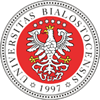Proszę używać tego identyfikatora do cytowań lub wstaw link do tej pozycji:
http://hdl.handle.net/11320/18353Pełny rekord metadanych
| Pole DC | Wartość | Język |
|---|---|---|
| dc.contributor.author | Malinowski, Jakub | - |
| dc.date.accessioned | 2025-07-15T07:50:20Z | - |
| dc.date.available | 2025-07-15T07:50:20Z | - |
| dc.date.issued | 2025 | - |
| dc.identifier.citation | Optimum. Economic Studies, Nr 2(120) 2025, s. 283-300 | pl |
| dc.identifier.issn | 1506-7637 | - |
| dc.identifier.uri | http://hdl.handle.net/11320/18353 | - |
| dc.description.abstract | Purpose | The purpose of this article is to identify a new catalog of personnel risks in small and medium-sized enterprises, a consequence of the dynamic development of the 4.0 economy. Research method | From the group of theoretical methods, the author used mainly analysis, synthesis, as well as inference. On the other hand, the empirical research was based on the method of surveying judgments and opinions with the survey technique, with a survey questionnaire constructed for the purpose of the research. Results | The changing economic conditions expand the catalog of personnel risks in small and medium-sized enterprises, and their impact on the achievement of operational, tactical and strategic organisational goals, should determine the implementation of improvements in policies aimed at identifying new sources of such risks. Personnel risk, among other things, through the interdisciplinary nature of references, affecting the frequency of its occurrence and the level of its impact, belongs to the group of the most dynamically developing area, requiring continuous monitoring. Originality / value / implications / recommendations | The result of the research implies the legitimacy of creating and regularly updating the used methods of risk identification and assessment, taking into account the new conditions of economy 4.0. | pl |
| dc.language.iso | en | pl |
| dc.publisher | Wydawnictwo Uniwersytetu w Białymstoku | pl |
| dc.subject | personnel risk | pl |
| dc.subject | inherent risk | pl |
| dc.subject | risk identification | pl |
| dc.subject | risk assessment | pl |
| dc.title | Identification and Assessment of Personnel Risk in SME – Theoretical and Research Perspective | pl |
| dc.type | Article | pl |
| dc.rights.holder | © Copyright by Uniwersytet w Białymstoku | pl |
| dc.identifier.doi | 10.15290/oes.2025.02.120.14 | - |
| dc.description.Email | j_malinowski@vp.pl | pl |
| dc.description.Affiliation | War Studies University | pl |
| dc.description.references | Aniszewska G., 2003, Geneza pojęcia „kultura organizacyjna”, ”Przegląd Organizacji”, vol. 10(765), pp. 17–20, DOI: 10.33141/po.2003.10.02. | pl |
| dc.description.references | Bochniarz P., Gugała K., 2005, Budowanie i pomiar kapitału ludzkiego w firmie, Poltex, Warszawa. | pl |
| dc.description.references | Cameron K.S., Quinn R.E., 2003, Kultura organizacyjna – diagnoza i zmiana, Oficyna Ekonomiczna, Kraków. | pl |
| dc.description.references | Covin J.G., 1991, Entrepreneurial versus Conservative Firms: A Comparison of Strategies and Performance, “Journal of Management Studies”, vol. 28, pp. 439–462, DOI: 10.1111/j.1467-6486.1991.tb00763.x. | pl |
| dc.description.references | Frieske K.W., 2012, Zamienił stryjek... „społeczne” na „rynkowe”, [in:] Zatrudnienie na czas określony w polskiej gospodarce. Społeczne i ekonomiczne konsekwencje zjawiska, Bednarski M., Frieske K. W. (eds), IPiSS, Warszawa. | pl |
| dc.description.references | Kasiewicz S., Kurkliński L., 2023, Kultura ryzyka w warunkach postpandemicznych i transformacji cyfrowej w instytucjach finansowych, ”Bezpieczny Bank”, no. 3(92), pp. 88–107, DOI: 10.26354/bb.5.3.92.2023. | pl |
| dc.description.references | Knight F.H.,1921, Risk, Uncertainty, and Profit, Houghton Mifflin, New York. | pl |
| dc.description.references | Krause M., 2011, Praktyczne aspekty doboru metod oceny ryzyka zawodowego, ”Zeszyty Naukowe Politechniki Śląskiej Organizacja i Zarządzanie”, vol. 59, pp. 173–190. | pl |
| dc.description.references | Krivkovich A., Levy C., 2013, Managing the People Side of Risk, ”McKinsey Quarterly”, no. 4, pp. 3–6. | pl |
| dc.description.references | Kulp C.A., 1928, Causality Insurance, Ronald Press, New York. | pl |
| dc.description.references | Lipka A., 2002, Ryzyko personalne. Szanse i zagrożenia zarządzania zasobami ludzkimi, Poltext, Warszawa. | pl |
| dc.description.references | Mokaya S.O., 2012, Corporate Entrepreneurship and Organisational Performance, Theoretical Perspectives, Approaches and Outcomes, “International Journal of Arts and Commerce”, vol. 1, no. 4, pp. 133–143. | pl |
| dc.description.references | Murray-Webster R, 2010, Management of Risk: Guidance for Practitioners, Office of Government Commerce, Great Britain. | pl |
| dc.description.references | Oreg S., Vakola M., Armenakis A., 2011, Change Recipients’ Reactions to Organisational Change: A 60-year Review of Quantitative Studies, “Journal of Applied Behavioral Science”, vol. 47(4), pp. 461–524, DOI: 10.1177/0021886310396550. | pl |
| dc.description.references | Piwowar-Sulej K., 2010, Kultura organizacyjna w zarządzaniu przez projekty, [in:] Społeczne wymiary zarządzania nowoczesnymi przedsiębiorstwami. Ludzie, kultura organizacji, społeczna odpowiedzialność, Stankiewicz J. (ed.), Uniwersytet Zielonogórski, Zielona Góra. | pl |
| dc.description.references | Shelest O., 2013, Ocena czynników ryzyka personalnego w administracji publicznej. Na przykładzie Urzędu Miasta Poznania, ”Konteksty Społeczne”, vol. 1(1), pp. 75–83. | pl |
| dc.description.references | Skowron-Grabowska B., Mesjasz-Lech A., 2016, Konkurencyjne uwarunkowania zarzą dzania zasobami kadrowymi w przedsiębiorstwach w kontekście dostępu do rynku pracy, ”Przegląd Organizacji”, no. 10(921), pp. 22–28, DOI: 10.33141/po.2016.10.03. | pl |
| dc.description.references | Tyrańska M., 2007, Rola systemu informacji kadrowej w zarządzaniu ryzykiem personalnym, ”Zeszyty Naukowe Małopolskiej Wyższej Szkoły Ekonomicznej w Tarnowie”, vol. 1(10), pp. 157–178. | pl |
| dc.description.references | Wasiluk P., 2017, Innowacyjny model biznesowy jako determinanta efektywnego zarządzania przedsiębiorstwem, ”Modern Management Systems”, vol. 3, pp. 95–105. | pl |
| dc.description.references | Woźniak J., 2020, Risk Management Integration in Creative Industries, ”Przegląd Organizacji”, no. 4(963), pp. 3–12, DOI: 10.33141/po.2020.04.01. | pl |
| dc.description.references | Yazici H.J., 2011, Significance of Organisational Culture in Perceived Project and Business Performance, “Engineering Management Journal”, vol. 23(2), pp. 20–29, DOI: 10.1080/10429247.2011.11431892. | pl |
| dc.description.references | Zawiła-Niedźwiecki J., 2010, Pojęcie ryzyka operacyjnego i klasyfikacja jego rodzajów, ”Przegląd Organizacji”, no. 6, pp. 19–21, DOI: 10.33141/po.2010.06.05. | pl |
| dc.description.references | Zawiła-Niedźwiecki J., 2013, Zarządzanie ryzykiem operacyjnym w zapewnieniu ciągłości organizacji, edu-Libri, Warszawa–Kraków. | pl |
| dc.description.references | Ziemski J., 2016, Mapa ryzyka jako mieszana metoda oceny ryzyka w przedsiębiorstwie. „Zeszyty Naukowe. Organizacja i Zarządzanie”, vol. 96, pp. 549–556. | pl |
| dc.description.references | www 1, https://www.ca.pw.edu.pl/content/download/3103/35463/file/1_Pomaranczowa%20ksiega%20_MF_2004.pdf [date of access: 5.07.20224]. | pl |
| dc.description.number | 2(120) | pl |
| dc.description.firstpage | 283 | pl |
| dc.description.lastpage | 300 | pl |
| dc.identifier.citation2 | Optimum. Economic Studies | pl |
| dc.identifier.orcid | 0000-0001-8610-350X | - |
| Występuje w kolekcji(ach): | Optimum. Economic Studies, 2025, nr 2(120) | |
Pliki w tej pozycji:
| Plik | Opis | Rozmiar | Format | |
|---|---|---|---|---|
| Optimum_2_2025_J_Malinowski_Identification_and_Assessment_of_Personnel_Risk_in_SME.pdf | 286,58 kB | Adobe PDF | Otwórz |
Pozycja jest chroniona prawem autorskim (Copyright © Wszelkie prawa zastrzeżone)

